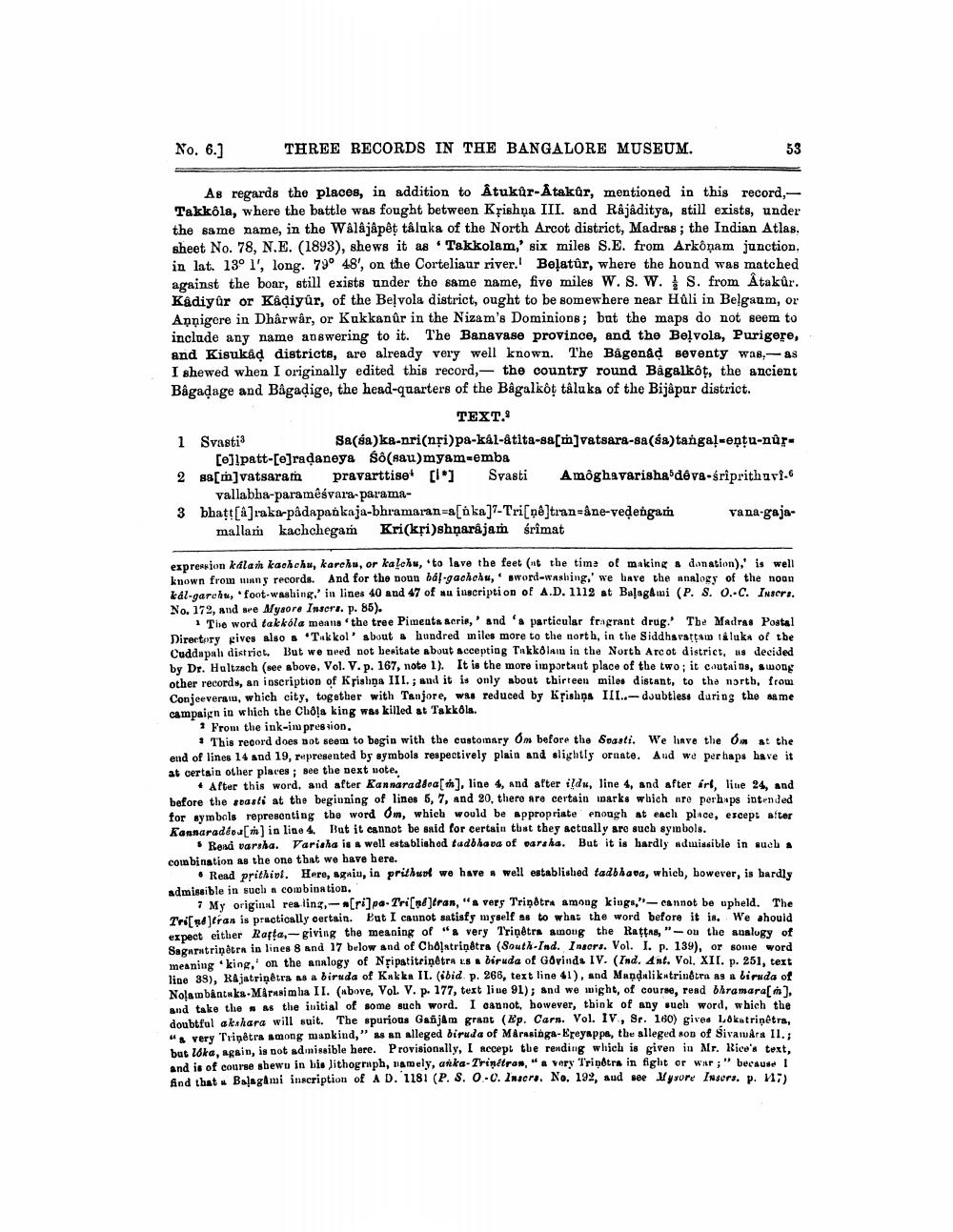________________
No. 6.]
As regards the places, in addition to Âtukûr-Åtakûr, mentioned in this record,— Takkôla, where the battle was fought between Krishna III. and Râjâditya, still exists, under the same name, in the Wâlâjâpêt tâluka of the North Arcot district, Madras; the Indian Atlas, sheet No. 78, N.E. (1893), shews it as Takkolam,' six miles S.E. from Arkonam junction. in lat. 13° 1', long. 79° 48', on the Corteliaur river. Belatûr, where the hound was matched against the boar, still exists under the same name, five miles W. S. W. S. from Atakûr. Kadiyûr or Kaḍiyûr, of the Belvola district, ought to be somewhere near Hûli in Belgaum, or Appigere in Dharwâr, or Kukkanûr in the Nizam's Dominions; but the maps do not seem to include any name answering to it. The Banavase province, and the Belvola, Purigere, and Kisukaḍ districts, are already very well known. The Bâgenâd seventy was, -as I shewed when I originally edited this record, the country round Bagalkôt, the ancient Bagaḍage and Bagadige, the head-quarters of the Bagalkot tâluka of the Bijapur district.
TEXT.'
THREE RECORDS IN THE BANGALORE MUSEUM.
Sa(sa)ka-nri(nri) pa-kâl-âtita-sa[m] vatsara-sa(sa) tangal-entu-nûr
Amôghavarisha déva-srîprithuvi.
1 Svasti3
[e]lpatt-[e]radaneya Sô(sau)myam-emba
2 sa[m]vatsaram pravarttise [*] Svasti
53
vallabha-paramêsvara-parama
3 bharaka-pidapatkaja-bhramaran-a[ka]-Tri[p]tran-Ane-vedeogath
mallam kachchegam Kri(kri)shnarajam śrîmat
vana-gaja
expression kálam kachchu, karchu, or kalchu, 'to lave the feet (at the time of making a donation), is well known from many records. And for the noun bál-gachchu, sword-washing,' we have the analogy of the noon kál-garchu, foot-washing,' in lines 40 and 47 of au inscription of A.D. 1112 at Balagami (P. S. o.-C. Insers. No. 172, and see Mysore Insers. p. 85).
1 The word takkóla means 'the tree Piments acris,' and 'a particular fragrant drug. The Madras Postal Directory gives also a Takkol' about a hundred miles more to the north, in the Siddhavaṭṭam taluks of the Cuddapah district. But we need not hesitate about accepting Takkolam in the North Arcot district, us decided by Dr. Hultzsch (see above, Vol. V. p. 167, note 1). It is the more important place of the two; it contains, among other records, an inscription of Krishna III.; and it is only about thirteen miles distant, to the north, from Conjeeveram, which city, together with Tanjore, was reduced by Krishna III..-doubtless during the same campaign in which the Chola king was killed at Takkola.
2 From the ink-impression.
This record does not seem to begin with the customary Om before the Svasti. We have the Om at the end of lines 14 and 19, represented by symbols respectively plain and slightly ornate. And we perhaps have it at certain other places; see the next note.
After this word, and after Kannaradeca[m], line 4, and after ildu, line 4, and after rf, line 24, and before the spasti at the beginning of lines 5, 7, and 20, there are certain marks which are perhaps intended for symbols representing the word 6m, which would be appropriate enough at each place, except after Kannaradéou[m] in line 4. But it cannot be said for certain that they actually are such symbols.
Read varsha. Varisha is a well established tadbhava of varsha. But it is hardly admissible in such a combination as the one that we have here.
Read prithivi. Here, again, in prithurt we have a well established tadbhava, which, however, is hardly admissible in such a combination.
7 My original realing,-[ri]pa-Tri[n]tran, "a very Tripêtra among kings," cannot be upheld. The Tri[n]tran is practically certain. But I cannot satisfy myself as to what the word before it is. We should expect either Rafta,-giving the meaning of "a very Trinêtra among the Rattas," on the analogy of Sagaratrinêtra in lines 8 and 17 below and of Cholatrinêtra (South-Ind. Insors. Vol. I. p. 139), or some word meaning king, on the analogy of Nripatitrinêtra us a biruda of Govinds IV. (Ind. Ant. Vol. XII. p. 251, text line 39), Rajatrinêtra as a biruda of Kakka II. (ibid. p. 266, text line 41), and Mandali katrinêtra as a biruda of Nolambántaka-Marasimha II. (above, Vol. V. p. 177, text line 91); and we might, of course, read bhramara[m], and take them as the initial of some such word. I cannot, however, think of any such word, which the doubtful akshara will suit. The spurious Ganjam grant (Ep. Carn. Vol. IV, Sr. 160) gives Lokatrinêtra, "a very Tripêtra among mankind," as an alleged biruda of Marasinga-Ereyappa, the alleged son of Sivamara 11.; but loka, again, is not admissible here. Provisionally, I accept the reading which is given in Mr. Rice's text, and is of course shewu in his lithograph, namely, anka- Trinetron," a very Tripêtra in fight or war;" because I find that a Balagami inscription of A D. 1181 (P. S. O-C. Insers. No. 192, aud see Mysore Insors. p. 7)




